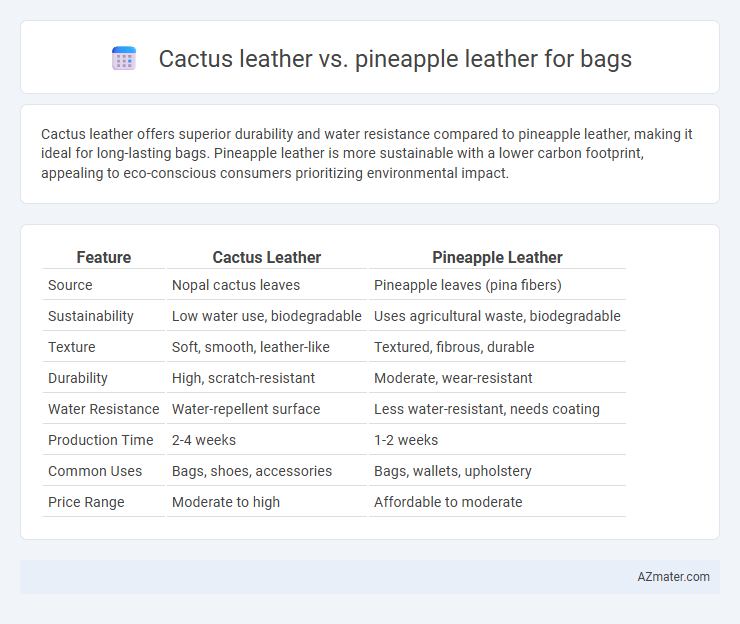Cactus leather offers superior durability and water resistance compared to pineapple leather, making it ideal for long-lasting bags. Pineapple leather is more sustainable with a lower carbon footprint, appealing to eco-conscious consumers prioritizing environmental impact.
Table of Comparison
| Feature | Cactus Leather | Pineapple Leather |
|---|---|---|
| Source | Nopal cactus leaves | Pineapple leaves (pina fibers) |
| Sustainability | Low water use, biodegradable | Uses agricultural waste, biodegradable |
| Texture | Soft, smooth, leather-like | Textured, fibrous, durable |
| Durability | High, scratch-resistant | Moderate, wear-resistant |
| Water Resistance | Water-repellent surface | Less water-resistant, needs coating |
| Production Time | 2-4 weeks | 1-2 weeks |
| Common Uses | Bags, shoes, accessories | Bags, wallets, upholstery |
| Price Range | Moderate to high | Affordable to moderate |
Introduction to Plant-Based Leathers
Plant-based leathers such as cactus leather and pineapple leather offer sustainable alternatives to traditional animal hides, reducing environmental impact and promoting cruelty-free fashion. Cactus leather, made from mature leaves of the nopal cactus, boasts durability and water resistance, making it ideal for high-quality bags. Pineapple leather, derived from the cellulose fibers of pineapple leaves known as Pinatex, provides a lightweight, breathable, and biodegradable material favored for eco-conscious handbag designs.
What is Cactus Leather?
Cactus leather, made from mature leaves of the nopal cactus, offers a sustainable and biodegradable alternative to traditional leather. It boasts a natural texture, durability, and water resistance, making it ideal for eco-conscious bag production. Compared to pineapple leather derived from pineapple leaves, cactus leather typically provides a thicker, more robust material with less processing required.
What is Pineapple Leather?
Pineapple leather, also known as Pinatex, is an innovative sustainable material made from the cellulose fibers of pineapple leaves, providing an eco-friendly alternative to traditional animal leather for bags. It offers a lightweight, durable, and breathable texture with a natural look that appeals to environmentally conscious consumers. Unlike cactus leather, pineapple leather is a byproduct of agricultural waste, making it a zero-waste material that supports circular fashion practices.
Production Process Comparison
Cactus leather production involves harvesting mature cactus leaves, drying them under sunlight, and grinding them into a fine pulp combined with non-toxic polyurethane for durability. Pineapple leather, or Pinatex, is made from pineapple leaf fibers extracted during fruit harvest, followed by a mechanical decortication process and treatment with eco-friendly resin to form a flexible textile. Both methods emphasize sustainable raw material sourcing with minimal chemical use, but cactus leather offers faster production cycles due to quicker plant regeneration compared to pineapple leaf harvesting.
Sustainability and Environmental Impact
Cactus leather offers a highly sustainable alternative to traditional materials, requiring minimal water and pesticides, which significantly reduces its environmental footprint compared to animal leather. Pineapple leather, derived from pineapple leaf fibers, utilizes agricultural waste, promoting waste upcycling and lowering the carbon footprint associated with production. Both materials contribute to eco-friendly fashion by reducing reliance on petrochemicals and promoting biodegradable alternatives, but cactus leather's drought-resistant cultivation presents greater water conservation benefits.
Durability and Performance
Cactus leather offers high durability with a natural resistance to water and scratches, making it ideal for long-lasting bags exposed to daily wear. Pineapple leather provides a softer texture but tends to be less resistant to abrasion and moisture, requiring more careful handling to maintain its appearance. Both materials perform well as sustainable alternatives to traditional leather, but cactus leather stands out for superior strength and environmental resilience.
Texture and Aesthetic Appeal
Cactus leather features a smooth yet slightly pebbled texture that mimics traditional leather, offering a luxurious and durable feel ideal for bags. In contrast, pineapple leather, made from Pinatex fibers, presents a more fibrous and matte surface with a natural, rustic aesthetic that emphasizes eco-friendly appeal. Both materials provide unique tactile experiences, with cactus leather delivering a sleek finish and pineapple leather highlighting sustainability-driven design.
Cost and Market Availability
Cactus leather typically costs between $30 to $60 per square foot, making it moderately priced compared to other plant-based alternatives, while pineapple leather ranges from $20 to $50 per square foot, often positioning it as a more affordable option. Pineapple leather enjoys wider market availability, especially in regions with abundant pineapple agriculture like Southeast Asia, whereas cactus leather remains less common but is gaining traction in sustainable fashion markets. Both materials face limited but growing supply chains, with pineapple leather benefiting from the valorization of pineapple leaf waste and cactus leather relying on slow-growing cactus plants, impacting mass production scalability.
Consumer Preferences and Trends
Consumers increasingly favor cactus leather and pineapple leather for bags due to their sustainable and eco-friendly properties. Cactus leather offers durability and a natural matte finish, appealing to buyers seeking long-lasting and stylish alternatives to traditional leather. Pineapple leather attracts trend-conscious consumers with its soft texture and vibrant patterns, aligning with the rising demand for innovative, plant-based materials in the fashion industry.
Final Verdict: Which is Better for Bags?
Cactus leather offers superior durability and water resistance compared to pineapple leather, making it ideal for long-lasting bag use. Pineapple leather excels in breathability and an eco-friendly profile due to its use of pineapple leaf waste, appealing to sustainable consumers. For bags requiring robustness and weather resistance, cactus leather is generally better, while pineapple leather suits those prioritizing sustainability and lightweight design.

Infographic: Cactus leather vs Pineapple leather for Bag
 azmater.com
azmater.com